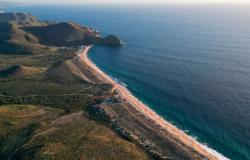In March, the Australian authorities stated that the world’s largest coral reef – the Great Barrier Reef – is once again affected by so-called mass bleaching.
It is the fifth time since 2016 that the phenomenon has hit the famous reef. The bleaching is caused by high temperatures in the sea, and poses a serious threat to the corals. If temperatures do not drop and the bleaching subsides quickly, they may die.
Climate researcher Bjørn Samset at Ciecero believes the mass bleaching will continue.
– Unfortunately, it looks quite dark for the corals. The way I see it, there is no way to stagger this now, he says.
THE WORLD’S LARGEST: The coral reef is over 2,600 kilometers long, covers an area of 347,800 km² and can be seen from space. In 1981 it was declared part of the World Heritage by UNESCO. Photo: Jumbo Aerial Photography / Great Barrier Reef Marine Park Authority / AP / NTB
view more
– Implies something
Samset believes that the corals off Australia are an example of how much damage global warming actually has.
– The corals are easily visible where they are located just below the surface. This is one of those places where we can easily see the consequences of global warming, he says and continues:
– They become a bit like the canary in the coal mine. These corals suggest something about the standing in the rest of the system.
Fear another planet
New area
The first time mass bleaching occurred in the reef’s 500-year history was in 1998, according to the Australian Institute of Marine Science (AIMS).
Mass bleaching is caused by persistently high water temperatures causing the corals to get rid of the algae zooxanthellae, which give them nutrition and colour.
Investigations are now underway to get an overview of the damage so far, writes NTB.
However, major damage has already been detected on part of the reef, which is 1,100 kilometers long, according to The Great Barrier Reef Marine Park Authority.
Record hot
The situation affects, among other things, southern parts of the reef, where centuries-old corals have been bleached.
– This bleaching event is taking place in an area where the corals have not previously been exposed to these extreme temperatures, says Richard Leck from the environmental organization WWF.
Study: Catastrophic decade for Australian coral reefs
The world’s southernmost coral reef, at Lord Howe Island outside New South Wales in Australia, is also affected, writes NTB.
As Dagbladet has written, 2023 was the warmest year that has so far been measured worldwide.
Although it is too early to determine how serious the bleaching will be this year, concern is now also spreading among many who have allowed themselves to be fascinated by the formerly so colorful Great Barrier Reef.






